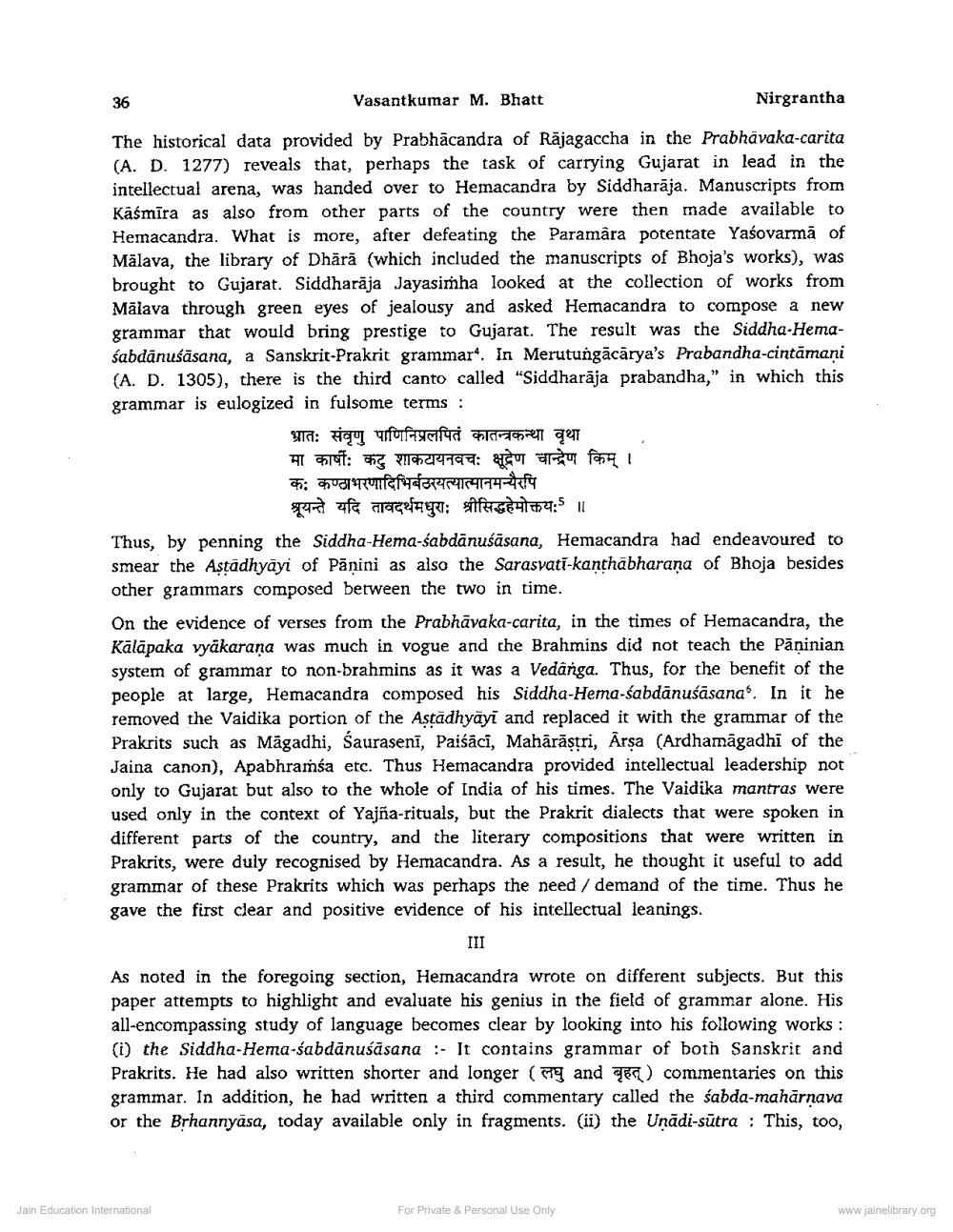Book Title: Kalikal Sarvagna Acharya Hemchandra A Re Appraisal Author(s): Vasant M Bhatt Publisher: Z_Nirgrantha_1_022701.pdf and Nirgrantha_2_022702.pdf and Nirgrantha_3_022703.pdf View full book textPage 2
________________ 36 Vasantkumar M. Bhatt Nirgrantha The historical data provided by Prabhācandra of Rājagaccha in the Prabhävaka-carita (A. D. 1277) reveals that, perhaps the task of carrying Gujarat in lead in the intellectual arena, was handed over to Hemacandra by Siddharāja. Manuscripts from Kaśmīra as also from other parts of the country were then made available to Hemacandra. What is more, after defeating the Paramâra potentate Yasovarmā of Mālava, the library of Dhārā (which included the manuscripts of Bhoja's works), was brought to Gujarat. Siddharāja Jayasimha looked at the collection of works from Mālava through green eyes of jealousy and asked Hemacandra to compose a new grammar that would bring prestige to Gujarat. The result was the Siddha-Hemasabdanuśāsana, a Sanskrit-Prakrit grammar. In Merutungācārya's Prabandha-cintamani (A. D. 1305), there is the third canto called "Siddharāja prabandha," in which this grammar is eulogized in fulsome terms: भ्रातः संवृणु पाणिनिप्रलपितं कातन्त्रकन्था वृथा मा कार्षीः कटु शाकटायनवचः शूद्रेण चान्द्रेण किम् । कः कण्ठाभरणादिभिर्बठस्यत्यात्मानमन्यैरपि श्रूयन्ते यदि तावदर्थमधुराः श्रीसिद्धहेमोक्तयः ।। Thus, by penning the Siddha-Hema-sabdānuśāsana, Hemacandra had endeavoured to smear the Astädhyāyi of Pāņini as also the Sarasvati-kanthābharana of Bhoja besides other grammars composed between the two in time. On the evidence of verses from the Prabhāvaka-carita, in the times of Hemacandra, the Kālāpaka vyäkarana was much in vogue and the Brahmins did not teach the Pāṇinian system of grammar to non-brahmins as it was a Vedānga. Thus, for the benefit of the people at large, Hemacandra composed his Siddha-Hema-sabdānušāsana. In it he removed the Vaidika portion of the Astādhyāyi and replaced it with the grammar of the Prakrits such as Mägadhi, Saurasenī, Paiśáci, Mahārāstri, Arsa (Ardhamāgadhi of the Jaina canon), Apabhraíba etc. Thus Hemacandra provided intellectual leadership not only to Gujarat but also to the whole of India of his times. The Vaidika mantras were used only in the context of Yajña-rituals, but the Prakrit dialects that were spoken in different parts of the country, and the literary compositions that were written in Prakrits, were duly recognised by Hemacandra. As a result, he thought it useful to add grammar of these Prakrits which was perhaps the need / demand of the time. Thus he gave the first clear and positive evidence of his intellectual leanings. III As noted in the foregoing section, Hemacandra wrote on different subjects. But this paper attempts to highlight and evaluate his genius in the field of grammar alone. His all-encompassing study of language becomes clear by looking into his following works : (i) the Siddha-Hema-sabdānusāsana :- It contains grammar of both Sanskrit and Prakrits. He had also written shorter and longer (79 and 6) commentaries on this grammar. In addition, he had written a third commentary called the sabda-mahārnava or the Brhannyāsa, today available only in fragments. (ii) the Unādi-sūtra : This, too, Jain Education International For Private & Personal Use Only www.jainelibrary.orgPage Navigation
1 2 3 4 5 6 7 8
